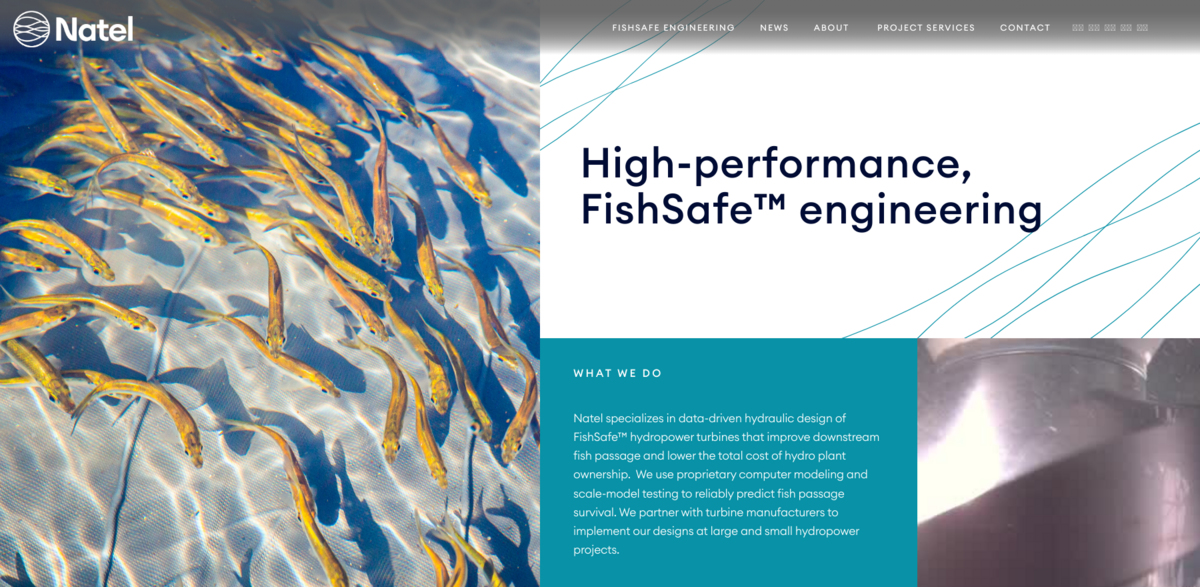What is the FishSafe™ Hydropower Turbine Project?
Natel specializes in data-driven hydraulic design of FishSafe™ hydropower turbines that improve downstream fish passage and lower the total cost of hydro plant ownership. Using proprietary computer modeling and scale-model testing, they reliably predict fish passage survival. The company partners with turbine manufacturers to implement these innovative designs at both large and small hydropower projects. Simply put, FishSafe™ turbines are engineered to be fish-friendly, making hydropower more sustainable without sacrificing efficiency.
Main Benefit of FishSafe™ Turbines
FishSafe™ hydropower turbines or plants cause negligible injury or mortality to all resident and migratory fish species passing downstream at all life stages, as compared to natural hazards encountered during a fish’s life cycle. The key benefits include:
- Significantly improved survival rates for fish passing through turbines
- Reduced environmental impact on aquatic ecosystems
- Lower total cost of hydro plant ownership due to efficient design
- Compatibility with a wide range of hydropower projects, big or small
- Enhanced collaboration with turbine manufacturers for seamless implementation
Testing Live Fish to Understand Turbine Impact
Testing live fish in a highly controlled environment is a powerful tool for understanding how different blade shapes and operating conditions affect fish of various species and life stages. A transparent turbine runner housing allows for capturing high-speed video, enabling direct observation and analysis of any potential interactions between fish and the runner. These experimental observations are crucial—they inform computer model predictions of survival through full-scale turbines, making sure the designs truly work in real-life conditions.
Advanced Computer Modeling and CFD Simulations
In addition to live fish testing, extensive computer modeling and computational fluid dynamics (CFD) simulations are the primary tools used to predict and validate the survival rates of fish in full-sized turbine designs. This combination of digital and physical testing ensures that FishSafe™ turbines are optimized for both performance and fish safety. The models help engineers tweak blade shapes and operating parameters before building actual turbines, saving time and resources.
Collaborations with Experts Worldwide
Natel collaborates with biologists, ecologists, and fish passage engineers around the world to design experiments and disseminate findings in scientific literature. This global teamwork is vital for advancing knowledge and improving turbine designs. The humane treatment of all fish used for turbine passage testing is not just an ethical priority but also a scientific necessity, ensuring that results are accurate and reliable. These partnerships help bridge the gap between engineering and ecology, pushing the boundaries of sustainable hydropower.
Project Impact on Sustainable Development Goals (SDGs)
- SDG 6: Clean Water and Sanitation – Protecting aquatic ecosystems by reducing fish mortality
- SDG 7: Affordable and Clean Energy – Enhancing hydropower efficiency with fish-friendly turbines
- SDG 14: Life Below Water – Minimizing harm to aquatic life and preserving biodiversity
- SDG 15: Life on Land – Supporting healthy river ecosystems that benefit terrestrial wildlife
- SDG 17: Partnerships for the Goals – Collaborating globally with scientists and engineers
Why FishSafe™ Turbines Matter
FishSafe™ turbines represent a leap forward in making hydropower truly sustainable. By combining cutting-edge technology with ecological sensitivity, these turbines help balance energy production with environmental stewardship. The approach is holistic—understanding fish behavior, testing in real conditions, and refining designs through advanced simulations. This means hydropower can continue to be a reliable energy source without compromising the health of fish populations or river ecosystems. It’s a win-win for energy and nature alike.





















